
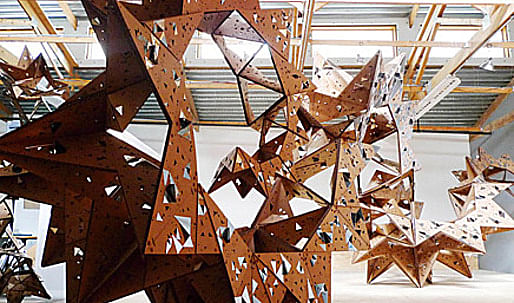
ShowCase is an on-going feature series on Archinect, presenting exciting new work from designers representing all creative fields and all geographies.
We are always accepting nominations for upcoming ShowCase features - if you would like to suggest a project, please send us a message.
Like seeing eye dogs, miniature service horses, assisting chimps and parrots, Architecture Service Animals are not merely to be looked at; they are to be looked with . They are structural organizations bred for the apperception of space and matter.
Chicago’s Architecture Service Animal is named Sid. Sid is a mongrel.
Sid has a sister that lived in Casablanca, Morocco for 2 weeks. Sid’s sister had no name, but enjoyed her time in North Africa.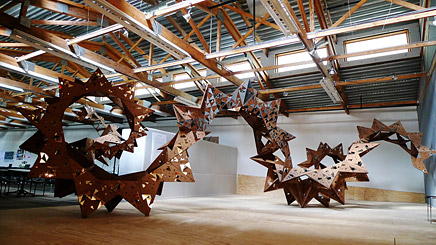
↑ Click image to enlarge
SEA: Seeing Eye Architecture CHICAGO
Sid and his sister are bred following nature as a model. Nature does not design a dog. Nature designs dogs. No dog is ever only one dog, it is a singular instant of species in constant change; it is singularly plural. A hound breeder will work within the constraints of a living system, the hound, and manipulate the form of that particular animal to perform a certain intentional future role in the hunt. For instance, three offspring generations from the present, the hound as a system can be manipulated to perform as a pointer, a hunter, or a caller. Depending on the breeding techniques and the performance needs in the space of the pack and the field, the hound as system can be bred to become a sight hound for coursing speed, a scent hound to find the trail and lead the hunters, or a lurcher for working. The hound is a service animal in the service of the hunt. Systems manipulation allows an infinite set of form directions within a very finite set of parts. A hound can never be stretched into a giraffe, but breeding does allow a pack topology where an infinite set of hounds interior to the constraint is possible. Thus breeding allows for a space timing fit , a tuning of speeds and strength in space and acting, a tuning for an intentional performance in time. Likewise, the Architecture Service Animal Sid is a bred system not single designed form. This system allows for manipulability, for an organizational staging of possibilities rather than the puzzling of single design solution.
↑ Click image to enlarge
SEA: Seeing Eye Architecture CHICAGO
Sid has royal geometric bloodlines, purebred golden ratios found in the golden isosceles triangle. But Sid is also doctored with the fractal 3-dimensional spiraling genes of a romanesco cabbage. Sid’s body is grown from one simple base unit of corrugated cardboard.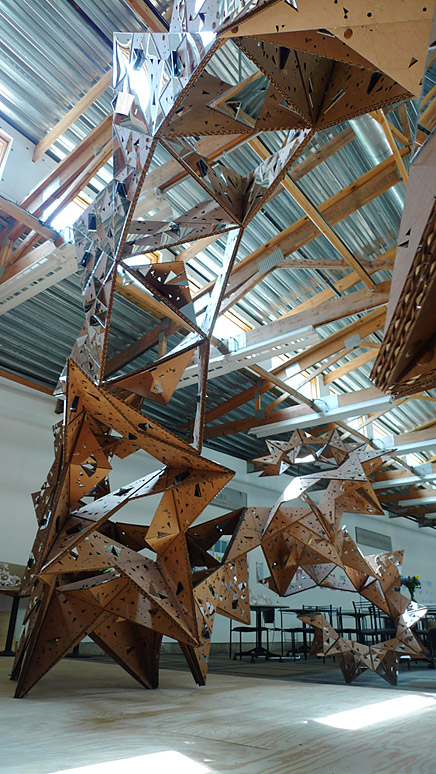
↑ Click image to enlarge
SEA: Seeing Eye Architecture CHICAGO
The single geometry of the golden isosceles is scaled up or down by rotation, such that the long side of the isosceles always becomes the short side of the next isosceles, or the long side becomes the next triangles short side. This introduces the organizational possibility of radical difference in a system of perpetual sameness. Each next scale up or down gives birth to another golden isosceles and a resultant fat isosceles triangle. In Sid, the 3-dimensional component is then grown by folding the 2-dimensional isosceles along the generational seam between the golden and the fat isosceles. These folded golden isosceles are then fastened to one another edge to edge, resulting in a spiral. Like all spirals, direction and form are inseparable. Their effect is their cause. Everything is an original. All the isosceles are originals while being reflections of each other and there are no copies. Each is indistinguishable from every other except in size and skin. This geometry allows the breeder a flea-bag kind of control and insures the survival of a species of same difference.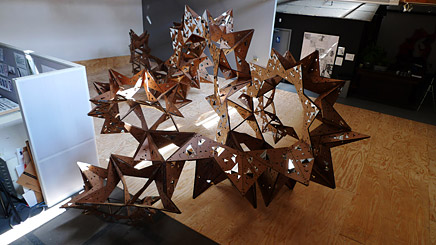
↑ Click image to enlarge
SEA: Seeing Eye Architecture CHICAGO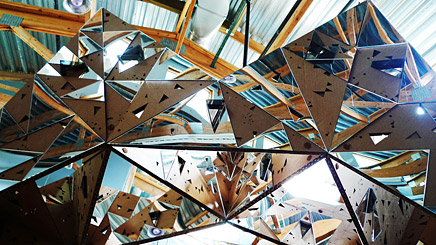
↑ Click image to enlarge
SEA: Seeing Eye Architecture CHICAGO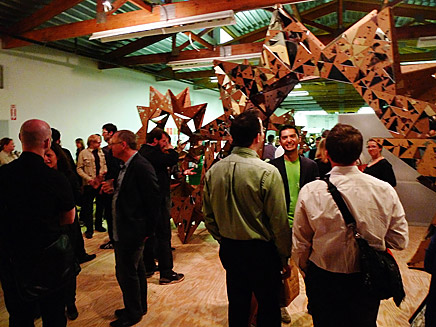
↑ Click image to enlarge
SEA: Seeing Eye Architecture CHICAGO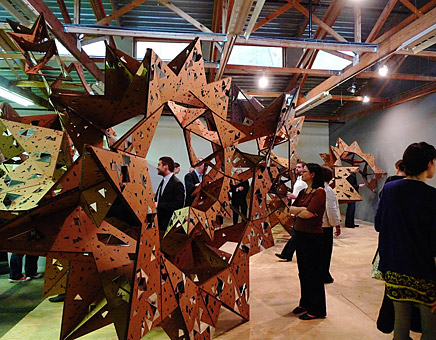
↑ Click image to enlarge
SEA: Seeing Eye Architecture CHICAGO
In Sid, the geometry always suggests options of self-organization, the next direction form where the animal can grow and what can grow there: a new spiral leg from a head, a new head from a hip, a foot, two tails for pointing in two directions, maybe a heart, if Sid wanted a heart, or a brain, if Sid ever wanted a brain, which Sid doesn’t want. Each of these direction forms are spirals which retain the relationships of the original starting point: the golden isosceles triangle. But the geometry doesn’t give the animal meaning. Sid has no meaning. Sid is a perception prosthetic, having a camouflage skin of mirrors and doors that reflects the space of the gallery and the pack the other species in the space of the gallery. As you look as Sid, you see the space around him. On the surface of the skin, the ceiling can share a surface with the floor with the person being reflected. Doors, or holes through Sid allow a person to see through Sid’s empty insides and extend into the gallery space as a perceptual space sieve.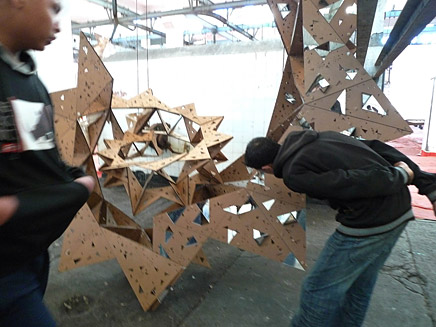
↑ Click image to enlarge
SEA: Seeing Eye Architecture CASABLANCA
↑ Click image to enlarge
SEA: Seeing Eye Architecture CASABLANCA
↑ Click image to enlarge
SEA: Seeing Eye Architecture CASABLANCA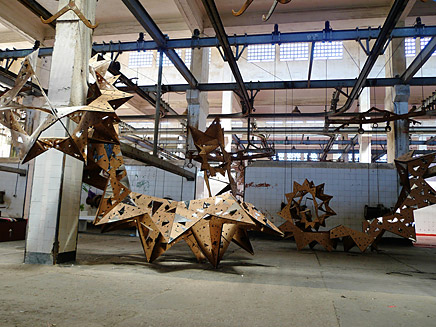
↑ Click image to enlarge
SEA: Seeing Eye Architecture CASABLANCA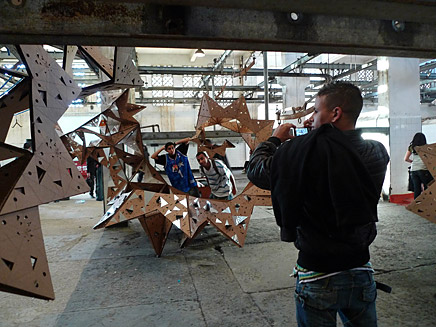
↑ Click image to enlarge
SEA: Seeing Eye Architecture CASABLANCA
↑ Click image to enlarge
SEA: Seeing Eye Architecture CASABLANCA
Architecture Service Animal’s are free standing. They are designed for the pragmatics of spatial stability and structural survival in the space of the gallery. But they are also designed for the luxury of looking, the space of wonder, the delight and pleasure in pattern and material organization, and for the perceptual fitting that takes place between matter, organization, space, and mind. Architecture Service Animals are not there for our emotional support or as comfort animals. They are working animals for our spatial re-abilities, not pets.
Species of Space breeders: Eric Ellingsen, John Castro, Ryan Szanyi, Michael Brassil, David Basham.
Sid Build Team: Eric Ellingsen, John Castro, Ryan Szanyi, Michael Brassil, David Basham, Isaac Plumb, Diba Salimi, David Rochlen, Maurizio Bianchi, Christopher Beckcom, Catherine Witt, Amelia Tabeling, Jacklynn Fitzgerald and Annie Nguyen.
SEA: Seeing Eye Architecture CHICAGO is sponsored by Extension Gallery, The Graham Foundation, Skidmore, Owings and Merrill LLP, the MLA program at IIT and the Driehaus Foundation, and the Chicago Sister Cities program, Casablanca –Chicago.
Special thanks to Donna Robertson, Peter Osler, Jesse Vogler, and Mason Pritchett.
SEA: Seeing Eye Architecture CASABLANCA was part of the les Transculturelles des Abattoirs in Casablanca, Morocco, the first Biennale in North Africa. Architectural curator was Aziza Chaouni (to whom special thanks is extended).
Creative Commons License
This work is licensed under a Creative Commons License .
/Creative Commons License
2 Comments
I love this.
getting tired of these aggregation systems i'm seeing everywhere
Block this user
Are you sure you want to block this user and hide all related comments throughout the site?
Archinect
This is your first comment on Archinect. Your comment will be visible once approved.